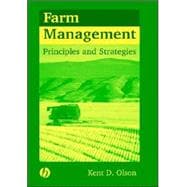
What is included with this book?
| Preface, | xi | ||||
| 1. The Scope of Farm Management, | 3 | (18) | |||
|
6 | (1) | |||
|
7 | (4) | |||
|
11 | (2) | |||
|
13 | (3) | |||
|
16 | (5) | |||
| 2. Strategic Management, | 21 | (48) | |||
|
22 | (1) | |||
|
23 | (1) | |||
|
24 | (37) | |||
|
61 | (3) | |||
|
64 | (5) | |||
| 3. Marketing Plan, | 69 | (16) | |||
|
69 | (4) | |||
|
73 | (5) | |||
|
78 | (3) | |||
|
81 | (4) | |||
| 4. Budgeting, | 85 | (42) | |||
|
86 | (9) | |||
|
95 | (6) | |||
|
101 | (8) | |||
|
109 | (18) | |||
| 5. Production and Operations Management, | 127 | (28) | |||
|
128 | (6) | |||
|
134 | (5) | |||
|
139 | (3) | |||
|
142 | (2) | |||
|
144 | (11) | |||
| 6. Quality Management and Control, | 155 | (34) | |||
|
156 | (2) | |||
|
158 | (1) | |||
|
159 | (11) | |||
|
170 | (12) | |||
|
182 | (7) | |||
| 7. Financial Analysis, | 189 | (44) | |||
|
190 | (16) | |||
|
206 | (12) | |||
|
218 | (8) | |||
|
226 | (7) | |||
| 8. Financial Management, | 233 | (18) | |||
|
233 | (2) | |||
|
235 | (2) | |||
|
237 | (1) | |||
|
238 | (7) | |||
|
245 | (6) | |||
| 9. Investment Analysis, | 251 | (24) | |||
|
251 | (7) | |||
|
258 | (17) | |||
| 10. Land Purchase and Rental, | 275 | (18) | |||
|
275 | (5) | |||
|
280 | (13) | |||
| 11. Risk Management, | 293 | (26) | |||
|
294 | (1) | |||
|
295 | (4) | |||
|
299 | (4) | |||
|
303 | (5) | |||
|
308 | (11) | |||
| 12. Production Contract Evaluation, | 319 | (16) | |||
|
320 | (1) | |||
|
321 | (3) | |||
|
324 | (11) | |||
| 13. Staffing and Organization, | 335 | (28) | |||
|
335 | (4) | |||
|
339 | (14) | |||
|
353 | (10) | |||
| 14. The Future Farm Manager, | 363 | (8) | |||
|
363 | (6) | |||
|
369 | (2) | |||
| Appendices | |||||
|
371 | (8) | |||
|
371 | (6) | |||
|
377 | (2) | |||
|
379 | (8) | |||
|
379 | (2) | |||
|
381 | (3) | |||
|
384 | (3) | |||
|
387 | (16) | |||
|
388 | (1) | |||
|
388 | (2) | |||
|
390 | (13) | |||
|
403 | (6) | |||
| Glossary, | 409 | (12) | |||
| Bibliography, | 421 | (4) | |||
| Index, | 425 |
The New copy of this book will include any supplemental materials advertised. Please check the title of the book to determine if it should include any access cards, study guides, lab manuals, CDs, etc.
The Used, Rental and eBook copies of this book are not guaranteed to include any supplemental materials. Typically, only the book itself is included. This is true even if the title states it includes any access cards, study guides, lab manuals, CDs, etc.